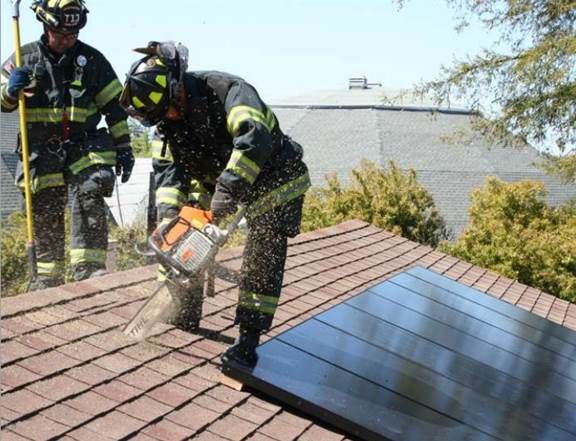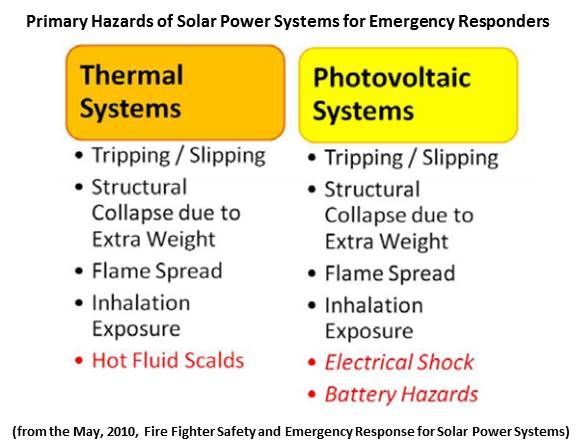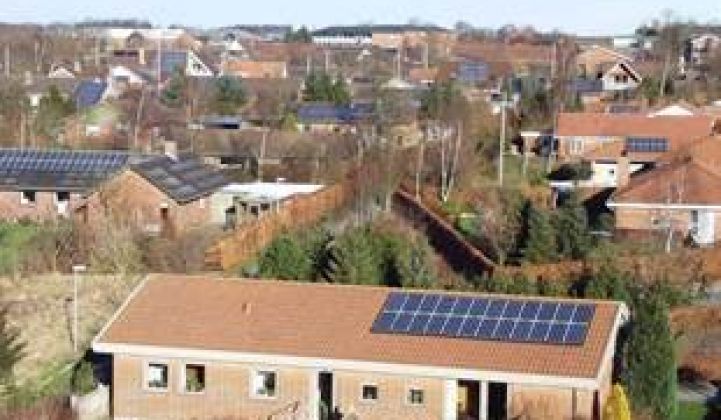Rooftop solar can make a threatening fire situation more complicated. A New Jersey warehouse recently burned for 29 hours and was almost completely destroyed in part because firefighters were hampered by a large rooftop solar PV array.
The New Jersey warehouse fire was not caused by the solar system. That is very rare. A German study found approximately 75 solar-caused fires out of some 1.3 million installations. A U.S study found only seven in the country.
A building fire’s smoke and gases rise with the heat, and firefighters must often vent them by opening the roof before they can take hoses inside to fight the source. “Since the PV modules cannot be cut through, and moving them is time-consuming and potentially dangerous, rooftop PV systems pose some risks -- mainly shock and trip hazards,” explained San Jose Fire Department's Matthew Paiss.
Firefighters usually have some understanding of electrical systems but will likely just vent around a solar array as long as the structure of the roof allows it, according to Paiss.

Firefighters should look for an inverter or conduit during their quick first site assessment, Paiss recommended. These should also be labeled when solar is installed, he added. Whether they are visible or labeled, the building’s main service panel should have a “solar present” label, according to guidelines from California’s Fire Marshal.
This is particularly important in the case of less easily spotted building-integrated PV systems, according to PV and fire authority Bill Brooks.
Shutdown of the building’s grid connection turns off the inverter. Battery backup systems, though low voltage, can add complications. They must be disconnected to fully eliminate the inverter as a potential variable. Battery acids and flammable gases must also be considered.
Even after the inverter is shut down, complications from rooftop solar remain. “There’s no easy way to shut off the high-voltage DC electricity flowing through the array and the DC wiring,” Paiss explained. “In daylight, when there is an open circuit, the modules are still putting out full voltage. There’s no current flowing -- that is, unless it finds a path to ground, like through a firefighter or through an ax breaking through walls or ceilings.”
When the sun is shining, wiring can carry enough solar-generated electricity “to injure or even kill a firefighter,” according to Paiss. “If a firefighter accidentally or deliberately axes through a string of twelve 44 VDC modules, he or she will experience a potentially deadly surge of 528 volts.”

Documented cases of firefighters being electrocuted by PV solar are rare, Paiss told The Atlantic. But the warehouse fire might have been less severe, a New Jersey fire official told Reuters, if safer roof access had allowed quicker venting.
If there is light on the modules, firefighters have to avoid potentially hot wiring. They also have to be aware that intact panels can turn wires hot the morning after a night fire. That could even potentially restart the fire. The best way to eliminate hazards is to stop the panels from generating electricity.
Module-level electronics offer one possible solution to a broad set of concerns, including arc faults and firefighting hazards.
“Code revisions at one point looked like they could require module-level devices,” GTM Research Senior Analyst MJ Shiao noted. But that did not happen, and they remain little used by the industry due to their increased costs and limited performance record.
The low-tech option is simply covering the panels. Heavy, opaque tarps can be used if they are available and the size and shape of the array permit it, according to the Fire Protection Research Foundation's May 2010 report, Fire Fighter Safety and Emergency Response for Solar Power Systems. Another FPRF-proposed idea is blanketing the panels with dispensable foam, but that has so far proven ineffective at securely blocking sunlight.
The safety of firefighters and other emergency first-responder personnel depends on training and preparation to handle the hazards, according to the FPRF report. “The single most critical message of emergency response personnel is to always consider photovoltaic systems and all their components as electrically energized when exposed to sunlight.”
Other best practices recommended by the report include:
- Proper labeling
- Training first responders to adhere to a “don’t touch until an assessment is made” rule
- Isolate the electrical system from first responders where possible
- First responders and system owners should have an installer “emergency contact”
- System owners should install interior fire sprinklers along with the rooftop array
- Owners should perform diligent maintenance
- At installation, owners should provide local fire authorities with a system schematic
“The industry has to come up with better solutions,” Shiao acknowledged, “but firefighters have to realize there are solar panels on more and more roofs and develop best practices to manage fires.”




